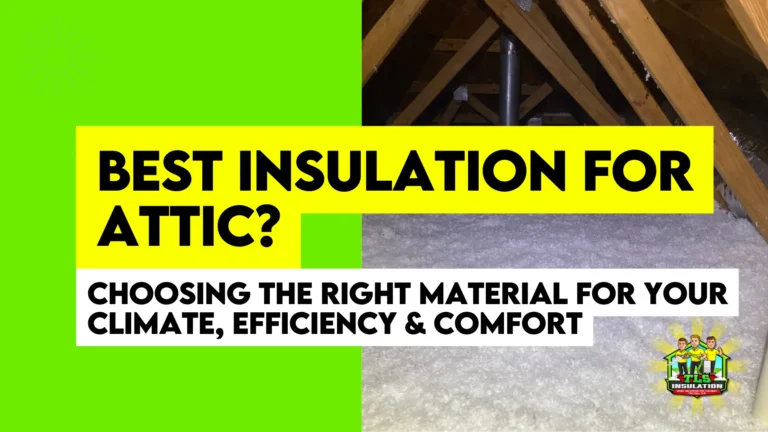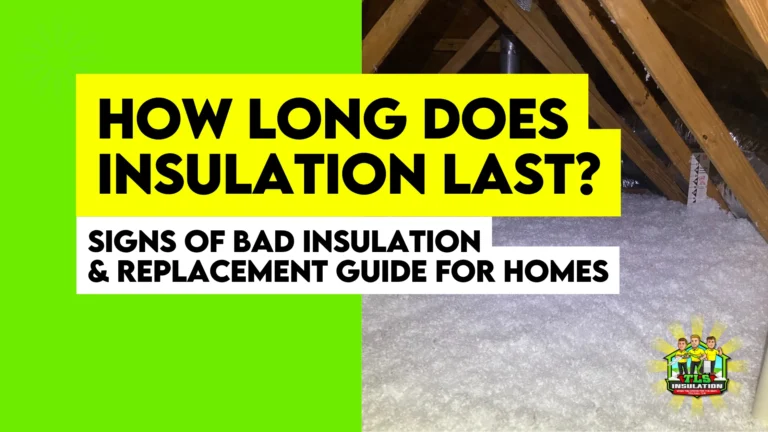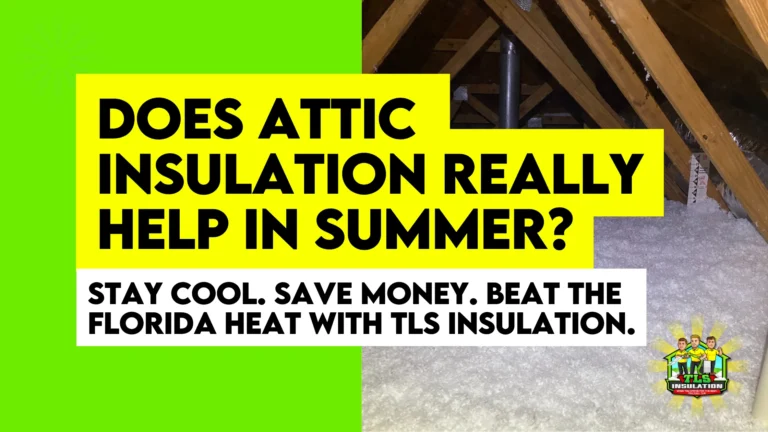Summary: The cost to insulate an attic typically ranges from $0.75 to $7.00 per square foot. For most homes, the total cost roughly falls between $1,200 and $3,500, depending on attic size, insulation material, and local factors. These pricing estimates vary based on region, ensuring you get a fair cost for your area’s climate and conditions.
How Much Does It Cost to Insulate Attic Insulation: Understanding Average Loft Insulation Pricing and Estimates
Disclaimer: All insulation prices mentioned here are industry estimates based on Florida market averages. Actual costs may vary depending on material choice, attic size, accessibility, removal requirements, and local labor rates. For the most accurate quote, request a professional on-site assessment or insulation audit.
The cost to insulate an attic varies depending on the material and attic size, typically ranging from $0.75 to $7.00 per square foot. For an average attic size of 1,000 sq. ft., homeowners can expect to pay between $1,200 and $3,500.
In humid regions like Florida, where moisture-resistant materials like spray foam are often preferred, the cost can increase up to $5.00 per square foot.
According to HomeAdvisor, the national average cost of attic insulation installation has risen by 19% since 2019.
Over the past decade, attic insulation prices have increased by 25%, driven by inflation, material shortages, and a growing demand for energy-efficient insulation. Post-COVID, labor and material costs remain volatile, further complicating price estimates.
Stop Guessing the Cost — Let TLS Insulation Do the Math for You!
Don’t waste hours estimating attic insulation prices. Get a free, no-obligation consultation with our certified Florida insulation experts.
- Free, no-obligation insulation consultation.
- Get your real-time attic insulation cost — no math, no stress.
- Expert estimate based on your attic, size, and material.

How Much Does It Cost to Insulate An Attic – Loft Insulation Cost Breakdown According to Material Type
Insulation Types and Practicality
| Insulation Type | Average Cost per Square Foot | Practicality |
|---|---|---|
| Fiberglass Insulation | $0.90 – $1.80 | Ideal for budget-conscious homeowners, fiberglass is the most affordable option, making it perfect for DIY projects. While cost-effective, it’s most practical for homeowners in humid climates. |
| Spray Foam Insulation | $1.50 – $5.00 | Offers excellent air sealing and moisture resistance, making it ideal for homes in humid climates. Though it’s a higher investment, it provides long-term energy savings and durability. |
| Cellulose Insulation | $1.20 – $3.20 | A green option, cellulose is affordable yet offers decent thermal performance. It works well in older homes but can settle over time, requiring possible reapplication. |
| Rigid Foam Insulation | $3.00 – $5.50 | Ideal for high moisture areas, rigid foam provides superior insulation and moisture resistance, but the installation cost is higher, making it best suited for specialized needs. |
| Reflective Insulation | $0.80 – $1.50 | Best for hot climates, this cost-effective option reduces cooling costs. While affordable, it’s generally combined with other materials for maximum energy efficiency. |
Fiberglass Insulation
Pros: Affordable, DIY-Friendly, Widely Available
Cons: Moisture Prone, Less Efficient, Settles Over Time
Fiberglass insulation costs between $0.90 to $1.80 per square foot, making it one of the most cost-effective solutions for attic insulation. With an R-value of 2.9 to 3.8 per inch, it provides decent thermal resistance, and provides real value for money for homeowners.
Ideal for homes with minimal moisture concerns, it’s also a popular and most practical option due to its low material cost and good coverage. Best for standard attic spaces where budget is a priority.
Spray Foam Insulation
Pros: Excellent Air Sealing, High Energy Efficiency, Moisture Resistant
Cons: Expensive, Professional Install, Difficult to DIY
Spray foam insulation typically costs between $1.50 and $5.00 per square foot, with high R-values ranging from 6.0 to 7.0 per inch. It is superior in air sealing and moisture resistance, making it ideal for homes in humid climates.
While it comes at a higher initial cost, it offers long-term savings by reducing energy bills and improving home comfort. Spray foam is especially effective in irregularly shaped attics or hard-to-reach areas, where traditional insulation types may fall short.
Cellulose Insulation
Pros: Eco-Friendly, Affordable, Good for Retrofit
Cons: Settles Over Time, Can Absorb Moisture, Labor-Intensive Install
Cellulose insulation ranges from $1.20 to $3.20 per square foot and offers an eco-friendly solution made from recycled paper. With an R-value of 3.2 to 3.8 per inch, it is a solid choice for homeowners seeking a green alternative.
It works well in retrofitting older homes, but it does settle over time and may require periodic reapplication. Its affordable pricing makes it a popular choice for those looking to improve energy efficiency without breaking the bank.
Rigid Foam Insulation
Pros: High R-Value, Moisture Resistant, Long-Lasting
Cons: Expensive, Hard to Install, Not DIY-Friendly
Rigid foam insulation costs $3.00 to $5.50 per square foot, providing a high R-value of 5.0 to 6.5 per inch. It is perfect for attics in high-moisture regions or homes needing maximum thermal resistance. While it comes at a premium cost, it offers long-term durability and moisture resistance that other materials cannot match.
Best for specialized applications like attic encapsulation or areas prone to condensation, rigid foam provides excellent performance at a higher upfront price.
Reflective Insulation
Pros: Cost-Effective, Cooling Efficiency, Lightweight
Cons: Limited in Cold Climates, Lower R-Value, Requires Combination
Reflective insulation is one of the most affordable options, with prices ranging from $0.80 to $1.50 per square foot. It’s most effective in hot climates, reflecting radiant heat and reducing cooling costs.
However, its R-value of 2.5 to 3.5 per inch is lower compared to other insulation types, so it’s best used in combination with other materials for optimal performance. Ideal for homes with direct sun exposure or extreme heat, reflective insulation can enhance energy efficiency without the high upfront costs of other materials.
Stop Guessing the Cost — Let TLS Insulation Do the Math for You!
Don’t waste hours estimating attic insulation prices. Get a free, no-obligation consultation with our certified Florida insulation experts.
- Free, no-obligation insulation consultation.
- Get your real-time attic insulation cost — no math, no stress.
- Expert estimate based on your attic, size, and material.

Average Cost to Insulate Attic by Climate Zones
The cost of attic insulation varies significantly across climate zones due to the different materials and installation needs required by each region. The U.S. Department of Energy divides the country into 8 climate zones, each with unique insulation requirements to address local temperature variations and humidity.
For example, hot-humid zones (Zone 1) demand more moisture-resistant materials like spray foam, which can drive up the cost of attic insulation. In cold climates (Zones 7-8), thicker insulation is needed to keep heat in, affecting attic insulation cost.
Loft Insulation Pricing Trends by Climate Zone:
- Zone 1 (Hot-Humid): Low to moderate insulation thickness required, focusing on moisture resistance.
- Zone 2 (Warm-Humid): Moderate insulation needs, focusing on both heat retention and moisture control.
- Zone 3 (Mixed Climate): Balanced insulation that addresses both cooling and heating needs.
- Zone 4-6 (Mixed to Cool): Thicker insulation for heat retention in colder winters.
- Zone 7-8 (Cold and Very Cold): High R-value insulation needed to minimize heat loss in harsh winters.
Climate Zone Pricing — Attic Insulation
| Climate Zone | Sub-Zones | Cities in Zone | Average Price of Attic Insulation | Cost per Square Foot |
|---|---|---|---|---|
| Zone 1 (Hot-Humid) | Zone 1A, 1B | Miami, Tampa, Houston, New Orleans | $1,500 – $2,800 | $1.50 – $2.80 |
| Zone 2 (Warm-Humid) | Zone 2A, 2B | Los Angeles, Phoenix, Austin | $1,200 – $2,400 | $1.20 – $2.40 |
| Zone 3 (Mixed Climate) | Zone 3A, 3B | Atlanta, Chicago, Denver | $1,400 – $2,500 | $1.40 – $2.50 |
| Zone 4 (Mixed to Cool) | Zone 4A, 4B | Seattle, Salt Lake City, Denver | $1,500 – $2,700 | $1.50 – $2.70 |
| Zone 5 (Cool) | Zone 5A, 5B | Boston, Minneapolis, Detroit | $1,600 – $2,800 | $1.60 – $2.80 |
| Zone 6 (Cold) | Zone 6A, 6B | Buffalo, Chicago, Bozeman | $1,700 – $3,000 | $1.70 – $3.00 |
| Zone 7 (Very Cold) | Zone 7A, 7B | Montreal, North Dakota, Upper Michigan | $1,800 – $3,500 | $2.00 – $4.00 |
| Zone 8 (Arctic) | Zone 8A, 8B | Alaska, Northern Minnesota | $2,000 – $3,800 | $2.00 – $5.00 |
Factors That Can Totally Turnaround Attic Insulation Estimates
The cost of attic insulation varies based on several factors that influence both material choice and installation complexity. These factors can increase or decrease the overall attic insulation cost per square foot, depending on the specific requirements of your attic space.
Type of Insulation Material
The choice of insulation material is one of the most significant cost drivers. The attic insulation cost per square foot can vary greatly between material types, with spray foam being one of the most expensive and fiberglass one of the most affordable. The average cost to insulate attic can range from $0.90 to $5.00 per square foot, depending on the material chosen.
- Fiberglass: Costs between $0.90 and $1.80 per square foot. It’s a great option for budget-conscious homeowners, but has a lower R-value compared to other materials.
- Spray Foam: Costs from $1.50 to $5.00 per square foot. It provides excellent air sealing and moisture resistance, making it ideal for humid climates, though it’s a higher upfront investment.
Attic Size and Square Footage
The size of the attic directly impacts the total cost of insulation. Larger attics require more material and labor, which increases the price to insulate attic. For instance, a 1,000 sq. ft. attic can range from $1,500 to $3,500 based on the insulation type, whereas smaller attics will cost less overall. The attic insulation cost per square foot tends to decrease as the attic size increases.
- Average 1,000 sq. ft. attic: $1,500 – $3,500
- Smaller attics: Typically between $1,200 – $2,500 depending on insulation type and location.
Labor Costs and Installation Complexity
Labor costs can account for a significant portion of the attic insulation cost. Depending on your region, labor charges typically range from $1.00 to $1.50 per square foot. The installation complexity also impacts cost. If your attic is difficult to access or requires additional services such as air sealing, it may raise the labor costs.
- Labor fees: $1.00 to $1.50 per sq. ft.
- Complex installations (e.g., hard-to-reach areas) may increase labor cost by 20-30%.
Regional and Climate Factors
Regional factors such as local climate conditions significantly influence both the choice of insulation material and pricing. For instance, in humid areas (like Florida), moisture-resistant materials such as spray foam are more expensive but necessary. On the other hand, in colder regions (like the Northeast), the cost of insulation is higher due to the thicker insulation required for heat retention.
- Humidity and moisture resistance: In areas like Florida, spray foam or cellulose can push costs up by 20%.
- Cold climates: Insulation in places like Minnesota or Montana may increase prices by 10-15% due to the need for high R-value materials.
Removal of Old Insulation
If you’re replacing old attic insulation, the cost of removal is an additional factor that can add to your overall expenses. Removal typically costs between $1.00 to $2.00 per square foot, depending on the amount of insulation to be removed and the condition of the old material (e.g., if it’s wet, moldy, or rodent-infested).
- Removal costs: $1.00 to $2.00 per square foot
- Mold/rodent damage: Can increase costs due to specialized cleaning and disposal.
Insulation R-Value and Thickness
The R-value (thermal resistance) of the insulation is directly tied to the cost. Higher R-values provide better insulation performance, leading to greater energy savings but at a higher initial cost. For example, R-30 insulation costs more than R-13 insulation. Insulation thickness also impacts attic insulation cost.
- R-13 insulation: Cheaper, good for mild climates
- R-30 to R-49 insulation: More expensive, best for colder regions.
How Much Does Attic Insulation Cost Based On Attic Size
Attic Size — Costs & Recommendations
| Attic Size | Cost Range | Recommended Insulation Types | Key Considerations |
|---|---|---|---|
| 800 sq. ft. | $800 – $4,000 | Fiberglass, Cellulose | Compact attics are easier and more affordable to insulate due to the smaller area, making them cost-efficient in terms of both materials and labor. |
| 1,000 sq. ft. | $1,000 – $5,000 | Fiberglass, Spray Foam | A typical attic size; cost-effective insulation options like fiberglass offer energy savings while spray foam ensures better moisture resistance. |
| 1,200 sq. ft. | $1,200 – $6,000 | Spray Foam, Reflective, Cellulose | Larger attics in humid areas like Florida may require higher moisture resistance and reflective insulation to enhance energy efficiency. |
| 1,500 sq. ft. | $1,500 – $7,500 | Spray Foam, Fiberglass, Rigid Foam | Larger attics can benefit from bulk material savings, although labor costs still play a significant role in the overall attic insulation cost per square foot. |
The cost per square foot generally decreases for larger attics due to bulk material savings, but labor costs can remain consistent. Typically, smaller attics are easier and less expensive to insulate, while larger attics require more material and labor, leading to a higher cost per square foot.
For example, the average cost to insulate attic spaces of 1,000 sq. ft. typically falls between $1,000 and $5,000, influenced by factors such as material selection, local labor rates, and any required moisture-resistant insulation in humid climates.
Similarly, for 1,200 sq. ft. attics, the cost ranges from $1,200 to $6,000, with regional differences impacting the pricing, humid climates like Florida often see higher costs for moisture-resistant materials like spray foam or reflective insulation.
Larger attic above 1,500 sq. ft., the cost typically ranges from $1,500 to $7,500. In this case, spray foam, fiberglass, or rigid foam are commonly used, depending on the attic’s needs for thermal performance and moisture resistance.
Additional Costs to Consider When Insulating Your Attic
- Moisture Barriers
In humid climates like Florida, moisture barriers are necessary to prevent mold, mildew, and insulation degradation. This adds $1.00 – $2.00 per square foot to your insulation cost but ensures long-term protection. - Air Sealing
Air sealing helps prevent air leaks and ensures maximum energy efficiency. The cost for air sealing can range from $0.50 to $1.00 per square foot, providing immediate savings by reducing energy waste. - Attic Ventilation
Proper ventilation ensures airflow and prevents heat buildup, which can damage insulation. The cost for ventilation systems can vary from $200 to $1,500, depending on the system size and complexity, but it significantly boosts overall energy efficiency. - Insulation Removal
If you’re replacing old or damaged insulation, removal costs can add up. Old insulation removal typically costs $1.00 – $2.00 per square foot, especially if there are issues like mold or pests. - R-Value Upgrades
Higher R-values for insulation materials, such as R-38 or R-49, are often required in colder climates. Upgrading to these higher-performance materials may increase costs by 10-20%, but it improves heat retention and energy savings. - Permits and Regulations
In certain areas, especially in older homes or specialized installations, you may need to get a permit. Permit costs can range from $50 to $500, depending on local regulations.
Frequently Asked Questions (FAQs)
How much does it cost to insulate a 1,500 sq ft attic?
Insulating a 1,500 sq ft attic typically ranges from $1,500 to $7,500, depending on the insulation material and labor costs. For instance, fiberglass batt insulation averages $1.50 per sq ft, while spray foam can go up to $5.00 per sq ft.
Does attic size affect insulation cost?
Yes, larger attics require more insulation material, increasing the overall cost. However, the cost per square foot may decrease for larger spaces due to bulk material savings.
How can I reduce attic insulation costs?
Taking a DIY approach to attic insulation can help reduce costs, with material and equipment rentals for a 1,000 sq. ft. attic typically ranging from $704 to $834. However, opting for professional installation ensures that the insulation is applied correctly and efficiently, making it a better choice for more complex or larger projects that require precise work.
How much does it cost to spray foam a 2,000 sq ft attic?
Spray foam insulation for a 2,000 sq ft attic generally costs between $4,000 and $8,000. This estimate varies based on the type of foam used and the attic’s accessibility.
What time of year is insulation cheapest?
Fall (September–November) is often the most cost-effective time to install insulation. Contractors have more availability, and pricing tends to be more competitive due to lower demand





